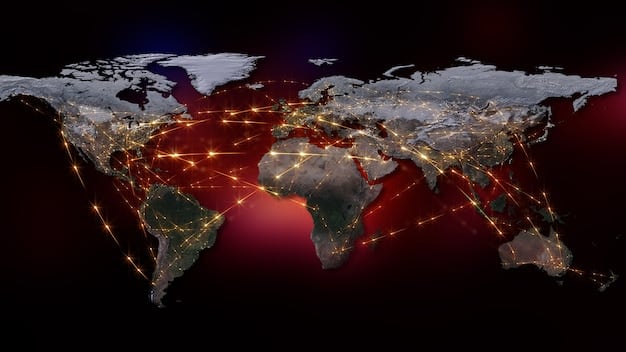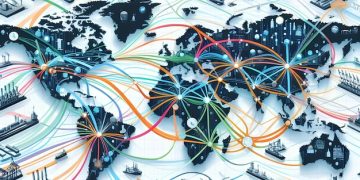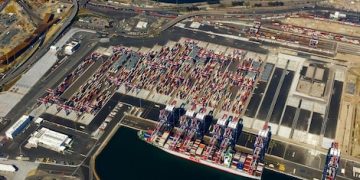Supply Chain Resilience: Navigating Risks in 2025

Supply chain resilience in 2025 will require businesses to proactively address economic uncertainties, geopolitical disruptions, and technological advancements through strategic planning, diversification, and enhanced collaboration.
In today’s rapidly changing global landscape, **supply chain resilience: mitigating risks in 2025 amidst global economic uncertainty** is not just a buzzword—it’s a necessity.
Understanding Supply Chain Vulnerabilities
Supply chains are the backbone of global commerce, but they are also vulnerable to a wide range of disruptions. Understanding these vulnerabilities is the first step toward building a more resilient supply chain.
Economic Instability
Economic instability, including recessions, inflation, and currency fluctuations, can significantly impact supply chains. These factors can lead to increased costs, reduced demand, and financial distress for suppliers.
Geopolitical Risks
Geopolitical risks, such as trade wars, political instability, and armed conflicts, can disrupt supply chains by blocking trade routes, creating regulatory hurdles, and increasing uncertainty.

These risks are increasing. Consider these points:
- Trade tensions between major economies can lead to tariffs and other trade barriers, disrupting supply chains.
- Political instability in key sourcing regions can result in production shutdowns and supply shortages.
- Armed conflicts can block trade routes and damage infrastructure, severely impacting supply chains.
To mitigate these risks, businesses need to diversify their sourcing, monitor geopolitical developments, and develop contingency plans.
In conclusion, economic and geopolitical factors pose significant challenges to supply chains. By understanding these vulnerabilities and taking proactive steps to mitigate them, businesses can build more resilient supply chains that can weather economic storms and geopolitical shocks.
The Impact of Technological Advancements
Technological advancements are transforming supply chains, offering both opportunities and challenges. Embracing these advancements is crucial for building resilience in 2025 and beyond.
Here’s how things are progressing:
Artificial Intelligence and Machine Learning
AI and machine learning can improve supply chain visibility, optimize inventory management, and predict potential disruptions. These technologies can help businesses make better decisions and respond more quickly to changing conditions.
Blockchain Technology
Blockchain technology can enhance supply chain transparency and security by providing a tamper-proof record of transactions. This can help businesses track products from origin to delivery, reducing the risk of fraud and counterfeiting.

These innovations can create real opportunities. For example:
- AI-powered predictive analytics can forecast demand more accurately, reducing the risk of stockouts and overstocking.
- Blockchain-based tracking systems can verify the authenticity of products, protecting consumers from counterfeit goods.
- Automation can improve efficiency and reduce costs in warehousing and transportation.
Businesses must invest in these technologies and develop the skills needed to use them effectively. By embracing technological advancements, businesses can build more efficient, transparent, and resilient supply chains.
In conclusion, technological advancements are reshaping supply chains in profound ways. By understanding and embracing these technologies, businesses can build more agile, responsive, and resilient supply chains that can thrive in the digital age.
Strategies for Building Supply Chain Resilience
Building **supply chain resilience** requires a multi-faceted approach that addresses potential disruptions at various points in the chain. Here are some strategies to consider.
Effective resilience can be built from:
Diversification of Sourcing
Diversifying sourcing can reduce reliance on any single supplier or region. This can help businesses mitigate the impact of disruptions caused by natural disasters, political instability, or economic factors.
Inventory Management
Optimizing inventory levels can help businesses buffer against supply disruptions. Maintaining safety stock can ensure that businesses have enough inventory to meet demand during periods of uncertainty.
To be more concrete, consider these points:
- Identifying alternative suppliers in different regions.
- Building relationships with multiple suppliers to ensure redundancy.
- Establishing a dual-sourcing strategy for critical components.
By diversifying sourcing and optimizing inventory management, businesses can build more robust supply chains that are better able to withstand disruptions.
In summary, diversifying sourcing and optimizing inventory management are essential strategies for building supply chain resilience. By implementing these strategies, businesses can reduce their vulnerability to disruptions and ensure business continuity.
Risk Assessment and Mapping
A comprehensive risk assessment is the foundation of any supply chain resilience strategy. Identifying potential risks and mapping their impact can help businesses prioritize mitigation efforts.
Identifying Potential Risks
Start by identifying all potential risks that could disrupt the supply chain. This includes natural disasters, geopolitical events, economic instability, and technological failures.
Mapping the Impact
Once you’ve identified potential risks, map their potential impact on the supply chain. This includes estimating the financial cost of disruptions, the time it would take to recover, and the impact on customer satisfaction.
Risk assessments might include considerations like:
- Conducting a vulnerability analysis to identify weak points in the supply chain.
- Developing a risk matrix to prioritize mitigation efforts.
- Performing scenario planning to prepare for different types of disruptions.
By conducting a thorough risk assessment, businesses can focus their resources on the most critical risks and develop effective mitigation strategies.
In conclusion, risk assessment and mapping are essential steps in building supply chain resilience. By identifying potential risks and mapping their impact, businesses can prioritize mitigation efforts and develop effective strategies for managing disruptions. This enables a proactive approach to risk management.
Collaboration and Communication
Effective collaboration and communication are essential for building supply chain resilience. Sharing information and coordinating efforts with suppliers, customers, and other stakeholders can help businesses respond more quickly to disruptions.
Building Strong Relationships
Foster strong relationships with key suppliers and customers. This can help businesses anticipate potential disruptions and coordinate responses more effectively.
Establishing Communication Channels
Establish clear communication channels with all stakeholders. This includes setting up regular meetings, sharing information through online portals, and using social media to communicate updates.
Here are ways to implement collaboration and communication:
- Creating a supply chain council to facilitate communication and collaboration.
- Using technology to share real-time information with suppliers and customers.
- Conducting joint risk assessments with key suppliers to identify potential vulnerabilities.
By fostering strong relationships and establishing clear communication channels, businesses can build more resilient supply chains that are better able to withstand disruptions.
In summary, collaboration and communication are critical components of supply chain resilience. By fostering strong relationships and establishing clear communication channels, businesses can respond more quickly to disruptions and minimize their impact.
Investing in Technology and Infrastructure
Investing in technology and infrastructure is crucial for building supply chain resilience in the long term. Modernizing infrastructure and adopting new technologies can improve efficiency, reduce costs, and enhance resilience.
Upgrading Infrastructure
Invest in upgrading infrastructure, such as roads, ports, and warehouses. This can improve the flow of goods and reduce the risk of disruptions caused by transportation bottlenecks.
Adopting New Technologies
Adopt new technologies, such as automation, robotics, and the Internet of Things (IoT). These technologies can improve efficiency, reduce costs, and enhance visibility throughout the supply chain.
Strategic investments might include:
- Implementing a transportation management system (TMS) to optimize logistics and reduce costs.
- Investing in warehouse automation to improve efficiency and reduce labor costs.
- Using IoT sensors to track the location and condition of goods in real time.
By investing in technology and infrastructure, businesses can build more efficient and resilient supply chains that are better able to compete in the global market.
In conclusion, investing in technology and infrastructure is essential for building long-term supply chain resilience. By modernizing infrastructure and adopting new technologies, businesses can improve efficiency, reduce costs, and enhance their ability to withstand disruptions.
| Key Point | Brief Description |
|---|---|
| 🌍 Diversify Sourcing | Reduce reliance on single region by finding suppliers from different geographic locations. |
| 🤖 Invest in Technology | Adopt AI, blockchain, and IoT for enhanced visibility and efficiency. |
| 🤝 Collaboration | Foster strong relationships with suppliers and customers for quicker disruption response. |
| 📊 Risk Assessment | Regularly assess risks and map their potential impact to prioritize mitigation. |
Frequently Asked Questions
▼
Supply chain resilience is the ability of a supply chain to withstand and recover quickly from disruptions. It involves proactive measures to minimize impact and ensure business continuity.
▼
It is important because it ensures business continuity by managing and mitigating disruptions. Resilient supply chains maintain competitive advantage and customer satisfaction even when crises arise.
▼
Companies can diversify sourcing by identifying alternative suppliers in different geographic regions. Building strong relationships with multiple suppliers and establishing a dual-sourcing strategy are also useful.
▼
Technology enhances resilience by improving visibility, automation, and data analytics. AI, blockchain, and IoT are key tools for optimizing supply chain operations and responding to disruptions quickly.
▼
Companies can establish clear communication channels with suppliers, customers, and stakeholders. Regular meetings, shared online portals, and social media are all useful so everyone remains informed.
Conclusion
In conclusion, **supply chain resilience** is paramount in 2025. By understanding vulnerabilities, embracing technology, diversifying sourcing, conducting risk assessments, and fostering collaboration. Businesses can navigate global economic uncertainties and build robust supply chains that ensure long-term success.





